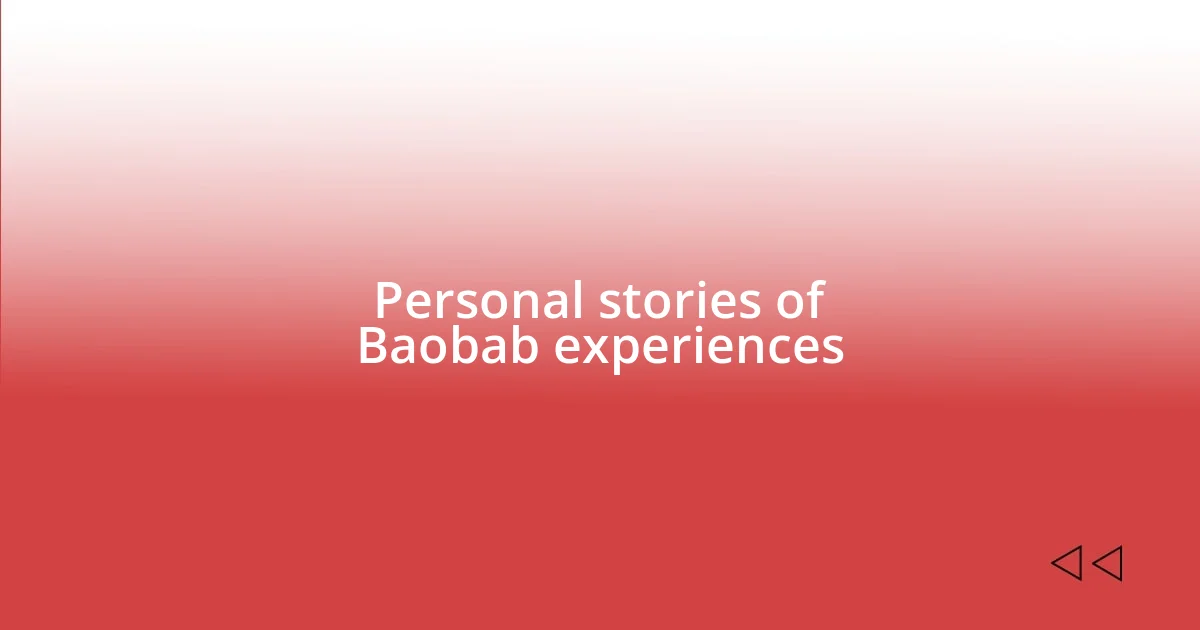Key takeaways:
- The baobab tree symbolizes resilience and survival, evoking deep emotional connections and memories tied to cultural heritage.
- Baobab fruit is a nutritional powerhouse, offering high vitamin C content and dietary fiber, while also supporting overall health and wellness.
- Baobabs serve as vital gathering places in communities, reinforcing social bonds and functioning as cultural symbols in traditions and rituals.

My first encounter with Baobab
The moment I first stood in the shadow of a baobab tree, I felt a rush of wonder. Its gigantic trunk and twisted branches looked like something from a storybook, almost otherworldly. I couldn’t help but ask myself, how could a tree be so magnificent?
As I traced my fingers along the rough bark, memories flooded back of old tales my grandmother used to share about these trees. I remembered her describing them as the “tree of life,” and I could understand why. Standing there, it felt as if the baobab held secrets from centuries past, whispering stories of resilience and survival.
Then, as the sun began to dip below the horizon, casting a warm glow over the scene, I felt an overwhelming connection to this ancient giant. Has anyone else experienced such a profound bond with a tree? In that moment, beneath the sprawling branches, I realized I was not just admiring a beautiful tree; I was embracing a part of my own journey, intertwined with its history.

Discovering Baobab’s unique features
The baobab tree is renowned for its extraordinary trunk, which can store thousands of liters of water. I remember standing with my friends, marveling at how one tree could survive harsh droughts just by holding onto this precious resource. It’s fascinating to think that, during dry spells, the baobab transforms into a life-sustaining oasis for both animals and humans alike.
One unique feature that truly left me in awe is the baobab’s fruit, often referred to as the “superfood” of the African landscape. The first time I tasted its tangy pulp, I was surprised by its refreshing flavor and high vitamin C content. This experience made me realize how this tree contributes not just ecologically but also nutritionally, nourishing the communities that surround it.
When you look at the baobab, its silhouette is striking — it almost looks like a giant rooted upside-down. I chuckled the first time I heard that comparison, but now I can appreciate the whimsicality of it. This quirky appearance doesn’t just make it a favorite subject for photographers; it weaves a deeper cultural narrative. Many communities view the baobab as a gathering place, reinforcing its role in social and communal life, creating bonds that span generations.
| Feature | Description |
|---|---|
| Water Storage | Stores thousands of liters to survive droughts. |
| Fruit | Nutritious pulp high in vitamin C, known as “superfood.” |
| Appearance | Striking silhouette, often compared to an upside-down tree. |
| Cultural Significance | Serves as a gathering place and strengthens community bonds. |

Cultural significance of the Baobab
The baobab tree isn’t just a natural wonder; it plays a pivotal role in the cultural tapestry of many African communities. I’ve heard stories during lively gatherings about how these trees serve as calendars, marking seasonal changes with their flowering cycles. Standing next to one, its massive presence tends to evoke not only admiration but also a sense of connection to history and a reminder of our ancestral roots. It’s as if these trees exist as living witnesses to the passage of time, echoing the rhythms of life that define cultural traditions.
- Gathering Places: In many villages, baobabs act as central meeting points where stories are shared, decisions are made, and friendships are forged.
- Spiritual Symbolism: Often regarded as sacred, baobabs are involved in cultural rituals and ceremonies, symbolizing longevity and wisdom.
- Traditional Medicine: Various parts of the baobab are used for healing and medicinal purposes, highlighting the tree’s importance in local healthcare practices.
- Art and Craft: The unique features of the baobab have inspired local artisans, resulting in handicrafts that reflect community identity.

Health benefits of Baobab fruit
One of the standout aspects of baobab fruit is its impressive nutritional profile. Packed with vitamin C, it has about six times more than oranges, which absolutely blew my mind when I first learned about it. Imagine how something so delicious can also help boost your immune system—now that’s what I call a double win!
In addition to vitamin C, the fruit is a fantastic source of dietary fiber. When I started incorporating baobab powder into my smoothies, I noticed a pleasant improvement in my digestion. It’s intriguing to think how such a simple addition to my diet could enhance gut health so effectively. Have you ever felt an instant boost of energy from a food? That’s how I felt after trying baobab!
Moreover, some research suggests that the antioxidants found in baobab may have anti-inflammatory properties. I still remember chatting with a friend who was trying to reduce inflammation naturally, and we stumbled upon this surprising benefit together. Isn’t it amazing how nature offers us these health treasures? Baobab not only tantalizes the taste buds but can also play a role in overall wellness.

Personal stories of Baobab experiences
Every time I’ve come across a baobab tree, it’s felt like stepping into a storybook. I recall a day under the expansive sky in a village where the baobab stood guard. As children played around its trunk, their laughter mingled with the whispers of elders sharing tales of bravery. It struck me then how this one tree could be the silent custodian of countless memories and traditions—do you ever wonder how many stories a single tree could hold?
On another occasion, while visiting a local market, I tasted baobab fruit for the first time, and oh, what a delightful surprise! The tangy flavor caught me off guard, yet there was something comforting about its taste that felt reminiscent of childhood treats. I found myself savoring every bite, realizing that this simple fruit could connect me to a whole culture. Has something ever tasted so good that it felt like an embrace from another world?
Finally, I remember standing beneath a baobab that seemed to extend infinitely into the sky, feeling an overwhelming sense of calm wash over me. Surrounded by nature, I took a deep breath and absorbed the beauty of my environment. In that moment, I understood how baobabs symbolize resilience and strength—qualities that we all aspire to embody. Can you think of a moment when nature reminded you of your own inner strength?

Conclusion on my Baobab journey
Reflecting on my journey with baobabs, I realize how much this exploration has deepened my appreciation for nature’s wonders. The first time I spotted a baobab, standing majestically against the sunset, it felt like meeting an old friend. Have you ever experienced that feeling of connection in nature—when everything just clicks?
It’s fascinating to think about how a single fruit can link to so many memories and lessons. When I began integrating baobab into my cooking, every dish transformed into a canvas of flavors and health benefits. The sheer joy of experimenting—like crafting a new smoothie recipe—reminded me that food is more than fuel; it’s a celebration of life. How has food inspired creativity in your life?
Ultimately, my encounter with the baobab has become a journey of discovery both for my body and spirit. I’ve found that this tree, rich in history and vitality, serves as a powerful reminder of resilience and growth. Isn’t it remarkable how nature teaches us these profound lessons, often when we least expect them?















